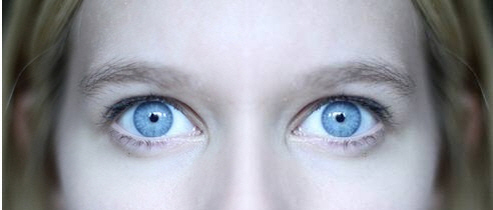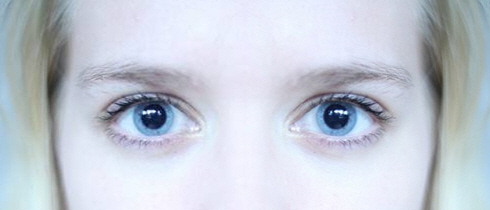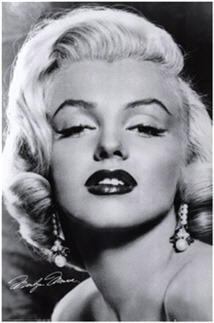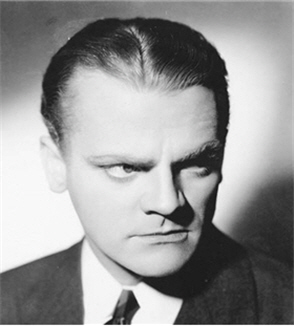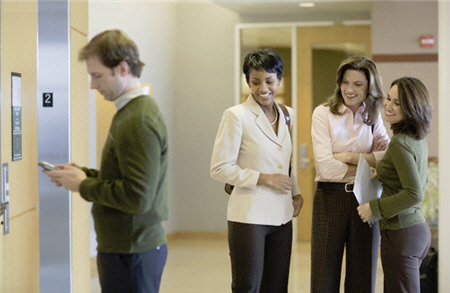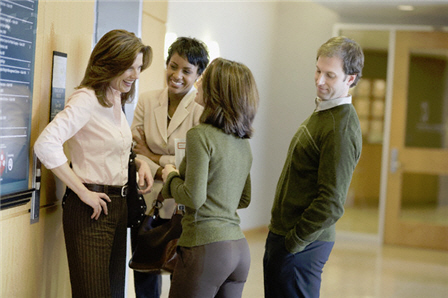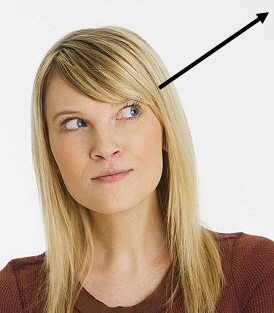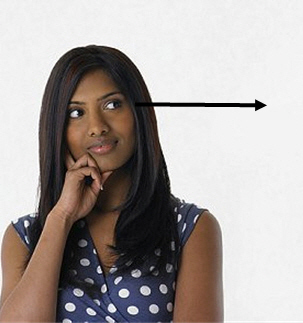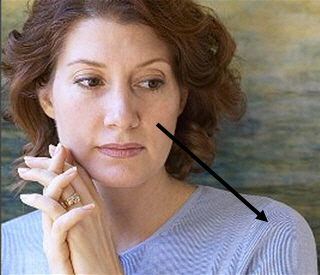Westside Toastmasters is located in West Los Angeles and Santa Monica, California
Chapter 8
THE EYES HAVE IT
Much of our face-to-face time with people is spent looking at their faces. The signals they send out with their eyes play a vital part in revealing their thoughts and attitudes. In fact, of all our body language signals, the eyes reveal our thoughts and emotions most accurately. They're placed in the strongest focal position on the body, and because the pupils respond unconsciously to stimuli they can't be artificially manipulated or controlled.
Your eyes are the gateway to the soul and reflect what's going on inside of you. They're also the means of seeing what's going on inside of someone else. When people meet for the first time they make a series of quick judgements about each other, based largely on what they see.
Communication through our eyes is most assuredly a two-way street in our complex society, we are interdependent on one another. Eye contact helps regulate conversation. Some people instinctively know how to use their eyes to their own advantage, to garner sympathy, convey sexual interest, or to deliver the message, 'Stay away!' With practice, your eyes can speak the messages you dare not say aloud. We look at the role that eyes play in communicating your feelings and intentions. Over the course of your life you discover how to use your eyes to command attention, display interest, show disapproval, create intimate feelings, and demonstrate dominance. Here, we will examine how to read the eye signals that others give you.

X-ray vision can come in handy
The Power Of Holding A Gaze
Establishing and maintaining eye contact comfortably with another person
can be the basis for successful communication, giving you and the person
you're communicating with a feeling of wellbeing and trust. Sometimes,
eye contact can be uncomfortable though, such as when the other person seems dishonest,
untrustworthy, or angry. Whether the interaction is comfortable or
not has to do, in part, with the way that a person looks, or doesn't look, at
you. The intensity and length of time she holds your eye influences the meaning
of the gaze. The following sections explain the different attitudes that a
held gaze can mean.
When a person holds your gaze he or she is telling you one of two things: They find
you attractive or interesting, or they may be feeling some anger or hostility towards
you for whatever reason and are offering you a non-verbal challenge. How do you tell the difference?
Look at their pupils: In the first case, the pupils should be dilated; in the
second, the pupils are constricted.
Adjusting Pupil Width
Confucius said, 'Look into a person's pupils. He cannot hide himself.' In given light conditions, your pupils will dilate or contract as your attitude and mood change from positive to negative and vice versa. When someone becomes excited, their pupils can dilate to up to four times their original size. Conversely, an angry, negative mood causes the pupils to contract to 'beady eyes' or 'snake eyes'. Lighter eyes can look more attractive because it's easier to see the dilation taking place.
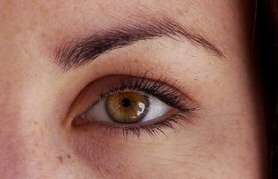
'Beady' eyes
Studying Pupils
University of Chicago biopsychologist Eckhard Hess developed pupillometrics to assess the size of the eye's pupil as a means of gauging emotion or interest. Hess discovered that the pupil enlarges when someone looks at something that stimulates him or her. When someone looks at uninteresting or personally unpleasant things, perhaps war scenes as an example, the pupils contract. In one of Hess's studies heterosexual men were shown retouched photographs of women. In half the photographs the women's pupils were made to look larger, in the other half the pupils were made to look smaller. With few exceptions, the men perceived the women with the larger pupils as being more attractive and friendlier than the same women whose pupils appeared smaller. When asked why they found one set of women more attractive than the other the men were unable to give an answer. None of the men remarked on the difference in the size of the pupils.
Retouching photographs of male and female models for print advertisements is common practice. The pupils are enlarged to make the models more attractive and alluring. Sales of manufactured goods measurably increase where close ups of the face are used to promote merchandise, especially in the worlds of fashion, cosmetics, and hair products.
Interestingly, Hess also found that increases in pupil size are positively correlated with problem solving mental activity, dilating to maximum size when a person has arrived at a problem solution.

Which picture do you find more attractive?
The eyes are a key signal in courtship and the purpose of eye make-up is to emphasize eye display. If a woman is attracted to a man her pupils will automaically dilate and he is likely to correctly decode this signal subconsciously without knowing it. This is why romantic encounters are most successful in dimly lit places because everyone's pupils dilate and create the impression that couples are interested in each other.
When lovers gaze deep into each other's eyes, they are unknowingly looking for pupil-dilation signals and each becomes excited by the dilation of the other's pupils. Research has shown that when pornographic films are shown to men their pupils can dilate to almost three times their size. Research shows that most women's eyes dilate to their extreme when looking at images of other mothers and children. The next time you get a chance, observe a mother watching her newborn child. Young babies and children have larger pupils than adults, and babies' pupils constantly dilate when adults are present in an attempt to look as appealing as possible and therefore receive constant attention. This is why the bestselling children's toys almost always have oversized pupils.
Research also shows that pupil dilation has a reciprocal effect on the person who sees the dilated pupils. Men looking at pictures of women with dilated pupils showed greater pupil dilation than when they looked at pictures of women with constricted pupils.
Take the Pupil Test
The ability to decode pupil dilation is hardwired into the brain and happens completely automatically. To test this, cover illustration B with your hand and ask someone to stare at the 'pupils' in illustration A. Then switch them to staring at illustration B and you'll see how their pupils dilate to match the illustration, because their brain thinks it's looking at eyes that find it attractive. Women's pupils dilate faster than men's to create rapport with what their brain sees as another person's eyes.
Hess conducted a pupil response experiment by showing five pictures to respondents: a naked male, a naked female, a baby, a mother and baby, and a landscape. Predictably, men's pupils dilated most at the naked female, gay men dilated most at the naked male but women's pupils dilated most at the picture of the mother and baby with the naked male picture coming in second.
Tests conducted with expert card players show that fewer games were won by the experts when their opponents wore dark glasses. If an opponent was dealt four aces in a game of poker for example, his rapid pupil dilation could be unconsciously detected by the expert, who would 'sense' he should not bet on the next hand. Dark glasses worn by the opponents eliminated pupil signals and, as a result, the experts won fewer hands than usual. These card playing dynamics can be readily observed on video channels showing Texas Hold'em poker tournaments where a number of players will wear darker glasses and / or baseball caps to help mask signals generated by the eyes.
The ancient Chinese gem traders were expert in watching their buyers' eyes when negotiating prices. If the pupils dilated, the trader knew she was offering too good a deal and had to negotiate harder. Courtesans and prostitutes were known to make themselves appear more enticing and desirable by putting drops of belladonna in their eyes to dilate their pupils.
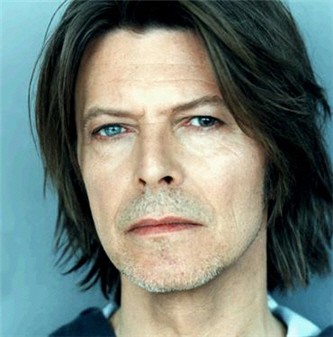
David Bowie had different-colored eyes (called Heterochromia), one blue and one hazel and permanently dilated. This was the result of a fight over a girlfriend at the age of 12.
An old cliche says, 'Look a person in the eye when you talk to them' when you are communicating or negotiating, but it's better to practice 'looking them in the pupil' as the pupils will tell you their real feelings.
Women Bear The Advantage
Some tests were conducted by Dr Simon Baron-Cohen at Cambridge University where subjects were shown photographs in which only a narrow strip of the face across both eyes was visible. The subjects were asked to choose between mental states expressed in the photographs such as 'friendly', 'relaxed', 'hostile' and 'worried' and attitudes such as 'desire for you' and 'desire for someone else'.
Statistically, pure guess work would result in half the answers being correct but men's average score was 19 out of 25 while women scored 22 out of 25. This test shows that both sexes have a greater ability to decode eye signals than body signals and that women are better at it than men. Scientists don't yet know how this eye information is sent or decoded, they simply know that we can do it. Autistic people - who are nearly all males - scored the lowest. Autistic brains lack the ability to read people's body language and this is one reason why autistic people have difficulty in forming social relationships, even though many have very high IQs.
We Could See The Whites Of Their Eyes
Humans are the only primates that have whites of the eye, known as the sclera - apes' eyes are completely dark. The white of the eye evolved as a communication aid to allow humans to see where other people were looking, because direction is linked to emotional states. Women's brains have more hardwiring than men's to read emotions, and one consequence of this is that women have more white of the eye than men. Apes lack eye-whites, which means that their prey don't know where the ape is looking or whether they have been spotted, giving the ape a greater chance of hunting success.
The Eyebrow Lift
This gesture is a long-distance 'hello' greeting signal which has been used everywhere since ancient times. The eyebrow lift is universal and is also used by monkeys and apes as a social greeting signal, confirming that it's an inborn gesture. The eyebrows rise for the briefest of moments and then drop again and its purpose is to draw attention to the face so that clear signals can be exchanged. The only culture that doesn't use it is the Japanese, where it's considered improper or impolite and has definite sexual connotations.
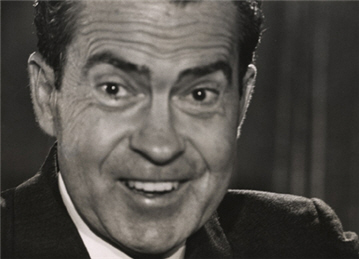
The eyebrow lift
This is an unconscious signal that acknowledges the other person's presence and is probably linked to the fear reaction of being surprised, or saying, 'I'm surprised and afraid of you', which translates to 'I acknowledge you and am not threatening'. We don't Eyebrow Flash strangers we pass in the street or people we don't like, and people who don't give the Eyebrow Flash on initial greeting are perceived as potentially aggressive. Try this simple test and you'll discover first hand the power of the Eyebrow Flash - sit in the lobby of a hotel and Eyebrow Flash everyone who goes past. You'll see that not only do others return the Flash and smile, many will come over and begin to talk to you. The golden rule is always Eyebrow Flash people you like or those who you want to like you.
Eye Widening
Lowering the eyebrows is how humans show dominance or aggression towards others, whereas raising the eyebrows shows submission. Researchers Keating & Keating found that several species of apes and monkeys use exactly the same gestures for the same purpose. They also found that people who intentionally raise their eyebrows are perceived as submissive by both humans and apes, and that those who lower them are perceived as aggressive.
Women can widen their eyes by raising their eyebrows and eyelids to create the 'baby face' appearance of a small infant. This has a powerful effect on men by releasing hormones into the brain, which stimulate the desire to protect and defend females. Women pluck and redraw their eyebrows higher up the forehead to appear more submissive because, on a subconscious level at least, they know it appeals to men. If men trim their eyebrows they do it from the top of the eyebrow down to make their eyes appear narrower and more authoritative.
John F Kennedy had what are known as 'medially down-turned' eyebrows, which gave his face a permanently concerned look that appealed to voters. If he'd had big bushy eyebrows like actor James Cagney's he would have had a less powerful impact on the electorate.
The 'Looking Up' Cluster

Princess Diana at the age of eight - like most young girls, she silently understood the impact of putting the head down and looking up
Lowering the head and looking up is another submissive gesture that appeals to men because it makes the eyes appear larger and makes a woman appear more childlike. This is because children are so much smaller than adults and spend their looking time gazing up and this creates a parenting reaction in both men and women.

Princess Diana used the 'Looking Up' cluster to evoke world empathy during her marital problems
Princess Diana made an art form out of keeping her chin down while looking up and exposing her vulnerable neck. This child like gesture cluster triggered maternal and paternal reactions towards her in millions of people, especially when she seemed to be under attack by the British Royal Family. People who use these submissive clusters usually don't practice them consciously but know that when they use them, they get a result
How To Light The Fire In Men
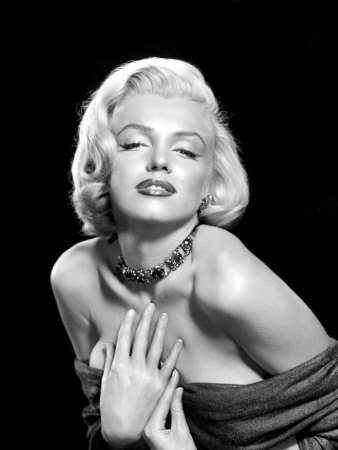
Marilyn Monroe was a master using pre-orgasmic expressions and body language, understanding at least subconsciously how to access men's emotional core
Lowering the eyelids while simultaneously raising the eyebrows, looking up and slightly parting the lips is a cluster that has been used by women for centuries to show sexual submissiveness. This is one of the historic trademarks of the sex sirens in cinema such as Marilyn Monroe, Mae West, or Elizabeth Taylor.
Not only does this gesture maximize the distance between the eyelid and eyebrows, it also gives the person a mysterious, secretive look and new research shows that this is the expression many women have on their faces immediately before having an orgasm.
Gaze Behavior - Where Do You Look?
It is only when you see 'eye to eye' with another person that a real basis for communication can be established. While some people can make us feel comfortable when they talk with us, others make us feel ill at ease and some seem untrustworthy. Initially, this has to do with the length of time that they look at us or with how long they hold our gaze as they speak.
Michael Argyle, a pioneer of social psychology and nonverbal communication skills in Britain, found that when Westerners and Europeans talk, their average gaze time is around 60%, consisting of 40% gaze time when talking, 75% when listening and 30% mutual gazing. He recorded the average gaze length to be 3 seconds and the length of a mutual gaze was 1.5 seconds. The amount of eye contact in a typical conversation ranges from 25% to 100%, depending on who's talking and what culture they're from. When we talk we maintain 40 to 60% eye contact with an average of 80% eye contact when listening. The notable exception to this rule is Japan and some Asian and South American cultures, where extended eye contact is seen as aggressive or disrespectful. The Japanese tend to look away or at your throat, which can be disconcerting for culturally inexperienced Westerners and Europeans.
Argyle found that when person A likes person B, he will look at him a lot. This causes B to think that A likes him, so B will like A in return. In other words, in most cultures, to build a good rapport with another person, your gaze should meet theirs about 60% to 70% of the time. This will also cause them to begin to like you. It is not surprising, therefore, that the nervous, timid person who meets our gaze less than one-third of the time is rarely trusted. This is also why, in negotiations, dark tinted glasses should be avoided as they make others feel you are either staring at them or trying to avoid them.
As with most body language and gestures, the length of time that one person gazes at another can be culturally determined. Always be sure to consider cultural circumstances before jumping to conclusions. The safest rule when travelling to places such as Japan is to mirror the gaze time of your hosts.
When two people meet and make eye contact for the first time, it's usually the person who is subordinate who looks away first. This means that not looking away becomes a subtle way to deliver a challenge or show disagreement when someone gives their opinion or point of view. Where the status of the other person is higher, however, for example, the person is your boss, you can send a clear message of disagreement by holding his gaze for only several seconds longer than would be usually acceptable. But it's not a good idea to do this regularly with your boss if you want to keep your job.
Maintaining Contact In Awkward Circumstances
Social researchers sent a group of people to a nudist colony and took a video of where they were looking when they were introduced to new people. All the non-nudist men reported that they had trouble resisting the urge to look down and the video replay showed how obvious it was when they did look down. The women said they did not experience these problems and rarely was a woman filmed intentionally gazing towards the pelvic area. This is because men are equipped with a form of tunnel vision that makes them far better than women at seeing directly in front of them and over long distances for spotting targets. Most men's close range and peripheral vision is far poorer than women's, however, which is why men have difficulty seeing things in refrigerators, cupboards and drawers. Women's peripheral vision extends to at least 45 degrees to each side, above and below, which means she can appear to be looking at someone's face while, at the same time, she is checking out their other personal assets.
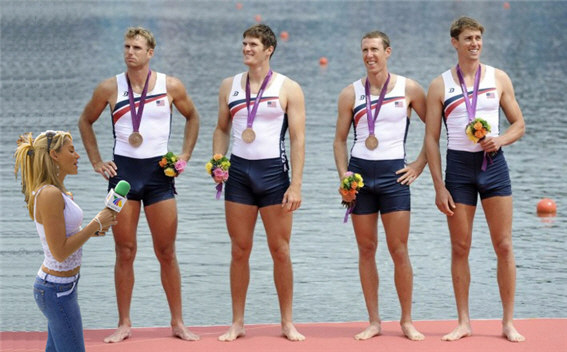
Women's wider peripheral vision lets them appear to be looking in one direction when they are, in fact, looking in another.
How to Lock In Men's Attention
When a woman wants to get a man's attention across a room she will meet his gaze, hold it for two to three seconds, then look away and down. This gaze is long enough for her to send him a message of interest and potential submission. An experiment by Monika Moore PhD, of Websters University, showed that most men are not hardwired to read a woman's first gaze signal so she usually needs to repeat it three times before the average man picks up on it, four times for really slow men and five or more times for the especially thick. When she finally gets his attention she will often use a small version of the Eyebrow Flash that is a small, subtle eye-widening gesture that tells him the signal was intended for him.
Sometimes a simple face-to-face verbal approach of 'Hey, I like you!' is more effective on men who are slow on the uptake.
Deceit Not So Difficult
Many people associate lying with looking away. In a series of experiments participants were told to tell a series of lies to others in interview videos. Viewers of the videos were asked to judge who was lying and who was not. What was discovered was contrary to a popular belief about liars. Approximately 30% of the liars constantly looked away when they lied and the viewers spotted these lies around 80% of the time, with women having a better catch rate than men. The other 70% of the liars maintained strong eye contact with their victim, assuming they were less likely to get caught if they did the opposite of what people expected. They were right. Lie-catching dropped to an average of 25%, with men scoring a dismal 15% success and women 35%. Women's more intuitive brains were better than men's in detecting voice changes, pupil dilation and other cues that gave the liar away. This shows that gaze alone is not a reliable signal of lying and you need to observe other gestures as well.
When a person's gaze meets yours for more than two-thirds of the time, it can mean one of two things: first, he finds you interesting or appealing, in which case he'll also have dilated pupils; or second, he's hostile towards you and could be issuing a challenge, in which case the pupils will be constricted. As mentioned, women are good at deciphering pupil signals and can differentiate interest from aggression, but men are significantly worse at doing it. This is why the average man can't tell if a woman is about to give him a kiss or a slap in the face.
Limiting Verbal Or Physical Aggression
Most primates avert their gaze to show submission. If an ape is going to display aggression or is likely to attack, it will lock eyes onto its victim. To avoid being attacked, the victim win look away and try to make itself appear smaller. Scientific evidence shows that submission behavior appears to be hardwired into primate brains for survival reasons. Under attack, we make ourselves appear smaller by hunching our shoulders, pulling our arms in close to the body, pressing our knees together and locking our ankles under a chair, dropping our chin to the chest to protect the throat and averting our gaze by looking away. These gestures activate an 'off switch' in the brain of the aggressor and the attack can be avoided.
This is an ideal position to take if you are being reprimanded by a superior when you actually deserve the reprimand, but it would be detrimental against a random street attack. From a person who is walking past a group of possible assailants in the street it would signal fear and this can contribute to inciting an attack. If you walk upright with larger movements, swinging your arms and legs and having your front open, you will project that you could defend yourself if necessary and so are less likely to be attacked.
The Sideways Glance
The Sideways Glance is used to communicate interest, uncertainty or hostility. When it is combined with slightly raised eyebrows or a smile, it communicates interest and is frequently used as a courtship signal, mostly by women. If it is clustered with down-turned eyebrows, furrowed brow or the corners of the mouth down-turned, it signals a suspicious, hostile or critical attitude.
Extended Blinking
A normal, relaxed blinking rate is six to eight blinks per minute and the eyes are closed for only about one tenth of a second. People under pressure, as when they are lying, will usually elevate their rate of eye blinking substantially.
Extended blinking is an unconscious attempt by the person's brain to block you from their sight because they've become bored or disinterested or feel they are of a higher caliber than those around them. It's as if their brain can no longer tolerate dealing with you so their eyes shut for two to three seconds or longer to wipe you from sight and remain closed as the person momentarily removes you from his mind.
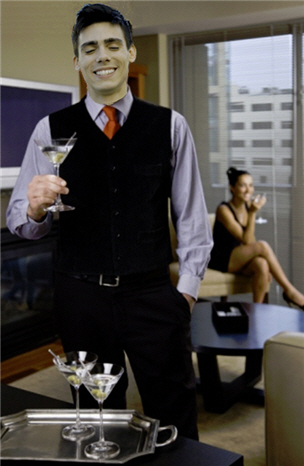
Shutting you out
Those believing they are a cut above you in social or economic class may tilt their head back, 'looking down one's nose' as it is known. People feeling that their essential importance is not being recognized will also display this gesture. This is primarly a Western cultural gesture, more frequently found in those defining themselves in the upper social class.
Darting Eyes
When the eyes dart from side to side it can look as if the person is checking out the activity in the room but the reality is that the brain is searching for escape routes (just as happens in monkeys and apes), revealing a person's insecurity about what is happening.
When you are with a particularly boring individual, your natural urge is to look away for escape routes. But because most of us are aware that looking away shows a lack of interest in the other person and signals our desire to escape, we look more at the boring individual and use a Tight-Lipped Smile to feign interest. This behavior parallels what liars are doing when they increase their eye contact to appear convincing.
The Geography of the Face
The geographical area of a person's face and body that you gaze upon can also dramatically affect the outcome of a face-to-face encounter.
When you've finished reading this next section, try out the techniques discussed - without warning anyone - and you'll experience the powerful effect these skills can have. It takes about a week of practice for these eye techniques to become a normal part of your communication skills.
There are three basic types of gazing: Social Gazing, Intimate Gazing and Power Gazing.
1. The Social Gaze
Experiments into gazing reveal that during social encounters the gazer's eyes look in a triangular area on the other person's face between the eyes and the mouth for about 90% of the gaze time.
This is the area of the face we look at in a non-threatening environment. The other person will perceive you as non-aggressive.
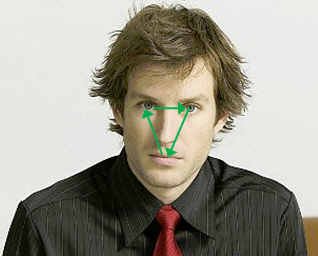
The Social Gazing area
2. The Intimate Gaze
When people approach each other from a distance, they look quickly between the other person's face and lower body to first establish what the sex of the person is and then a second time to determine a level of interest in them. This gaze is across the eyes and below the chin to lower parts of the person's body. In close encounters, it's the triangular area between the eyes and the chest and for distant gazing it's from the eyes to the groin or below.
Men and women use this gaze to show interest in each other and those who are interested will return the gaze. We usually give two quick glances and then look at their face and, despite most people's strong denials about it, hidden camera studies reveal that everyone does it, including nuns.
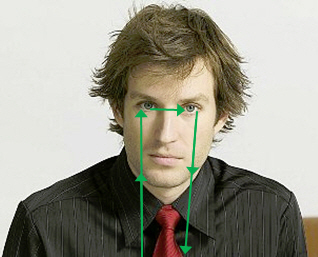
The Intimate Gaze zone
As noted earlier, a woman's wider-ranging peripheral vision, however, allows her to check out a man's body from head to toe without getting caught. Male tunnel vision is why a man will move his gaze up and down a woman's body in a very obvious way. This is also the reason why men are constantly accused of checking out women's bodies visually at close range but women are rarely accused of the same, even though research shows that women do more of it than men. It's not that men gawk more than women - men's tunnel vision means they keep getting caught. ... And, like it or not, everyone steals a look at a woman's rear when she leaves a room, even if they don't like her front view.
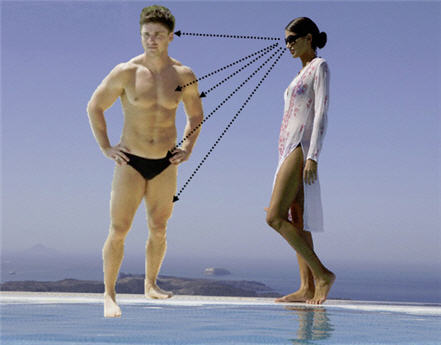
Women's wider peripheral vision means never getting caught; Men's Tunnel Vision means always getting caught
Looking down towards the ground during conversation serves different purposes for men and women. For a man, it lets him give a woman the once over. For a woman, it has the dual purpose of letting her check him out and at the same time send a submissive signal of looking away and down.
3. The Power Gaze
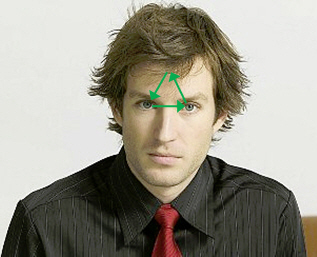
The Power Gaze
Imagine the person has a third eye in the center of their forehead and look in a triangular area between the person's 'three' eyes. The impact this gaze has on the other person has to be experienced to be believed.
Not only does it change the atmosphere to very serious, it can stop a bore dead in their tracks. By keeping your gaze directed at this area, you keep the screws firmly on them.
Provided your gaze doesn't drop below the level of their eyes, the pressure will stay on them. Never use this in friendly or romantic encounters. But it works a treat on the person who you want to intimidate or on the person who simply won't shut up.
The Power Stare
If you have soft, weak or wimpy eyes practice using the Power Stare to give yourself more authority. When you are under attack from someone, try not to blink while maintaining eye contact. When you look at the attacker, narrow your eyelids and focus closely on the person. This is what predatory animals do just before they strike their prey. When you pan your eyes from one person to another without blinking it has an unnerving effect on anyone who watches you do it.
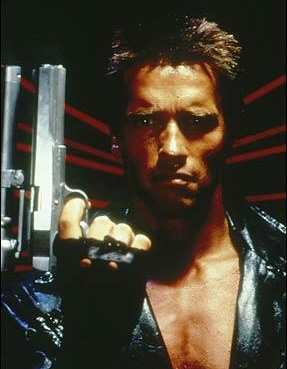
Don't mess with the Terminator
To do this, move your eyeballs first and then let your head follow, but your shoulders should remain still. The Power Stare was used by Arnold Schwarzenegger as The Terminator and can strike fear into the hearts of would-be intimidators. Better still, have a policy of dealing only with pleasant people so you'll never need to whip out your Power Stare.
The Politician's Story
When someone looks around from side to side or will not look us in the eye when they talk, our trust in their credibility diminishes significantly, even though they may be doing it because of shyness. A business associate had a politician as a client who was a novice at being interviewed on TV, constantly flicking his eyes between reporters and the cameras through an interview. This had the effect of making him look shifty-eyed to third party viewers and each time he appeared on TV his popularity decreased. Through training him to look at only the reporter and ignore the cameras, his credibility increased. Another politician was trained to address his answers mainly to the lens of the television camera when he participated in a televised political debate. While this alienated the 200 studio audience guests it impressed millions of television viewers, who felt as if the politician was talking directly to them.
Look Deep Into My Eyes
A social experiment was conducted using a dating service for a public media channel program. A selected number of men were told that a woman was well matched to them and that they should expect to have a good time on a date. To make this connection interesting, each man was told that his date had suffered an injury to one eye as a child which she was very sensitive about because the eye didn't track properly. The injured eye was unknown these men were told but if he looked closely he'd be able to pick it out. Each woman was also told the same story about her date and that if she too looked closely she'd be able to spot the slow eye. On their dates, the couples spent the evening gazing into each other's eyes searching in vain for the 'problem eye'. The outcome was that each couple reported high levels of intimacy and romance on their dates and the likelihood of the couple meeting again for a second date was 200% higher than the dating service average.
The First 20 Seconds of an Interview
Many people are taught that, in a sales or job interview, you should maintain strong eye contact with the other person and keep it up until you are seated. This creates problems for both the interviewer and interviewee because it's contrary to the process we like to go through when we meet someone new. A man wants to check out a woman's hair, legs, body shape and overall presentation. If she maintains eye contact it restricts this process so he's left trying to steal glances at her during the interview without getting caught and so he becomes distracted from the actual job of interviewing. Some women are disappointed that, in a supposedly equal business world, men still do this, but hidden cameras show this to be a fact of business life whether we like it or not.
Video cameras also reveal that women interviewers go through the same evaluation process with both male and female interviewees but women's wider peripheral vision means they rarely get caught. Women are also more critical than men of female interviewees whose appearance doesn't stack up. Women look at a male candidate's hair length, clothes design and co-ordination, the creases in his pants and shine on his shoes. Most men are completely unaware that women look at the condition of the back of his shoes as he walks out.
Solution
When you go for an interview, shake hands and then give the interviewer a two- to three-second frame of uninterrupted time for them to complete the process of looking you over. Look down to open your briefcase or folder, or to arrange any papers you might need, turn to hang up your coat, or move your chair in closer, and then look up. In filming sales interviews, we found that not only did the interviews feel better for the salespeople who used this strategy, it added up to a better outcome in sales results.
What Channel Are You Tuned To?
A person's eye movements can reveal what their mind is focusing on by telling you whether they are remembering something they have seen, heard, smelled, tasted or touched. This technique is a development of American psychologists Grinder and Bandler and is known as Neurolinguistic Programming, or NLP.
In simple terms, if a person is remembering something that they saw, their eyes will move upward. If they are recalling something they heard, they look to the side and tilt their head as if listening. If they are recalling a feeling or emotion, they'll look down and to the right. When a person is mentally talking to themselves, they look down and to the left.
The difficulty is that these eye movements can occur in a fraction of a second and come in clusters making it harder to read 'live'. A videotape replay, however, can let you see discrepancies between what a person says and what they really think.
Thirty-five per cent of people prefer the visual information channel and will use phrases such as 'I see what you mean' 'Can you look into that?', 'That's perfectly clear' or 'Can you show me that?' and you will get their attention by showing them photos, charts and graphs and asking if they 'Get the picture'.
Twenty-five per cent prefer the auditory channel and use words such as 'That rings a bell', 'I hear you', 'That doesn't sound right' and that they want to be 'in tune' with you. The other 40% prefer the feelings channel and will say 'Let's kick that idea around', 'Our department needs a shot in the arm', 'I can't quite grasp what you're saying'. They love to test drive things and be involved in a demonstration so that they can 'grasp the idea'.
How to Hold Eye Contact with an Audience
In audiences of up to 50 people it's possible to meet the gaze of each individual, letting them feel involved and keeping their attention. In larger groups you usually stand further back, so a different approach is needed. By pegging a real or imaginary point or person at each corner of the group and one in the center, when you stand at a distance of 10 yards (10m) from the front row, approximately 20 people in a group of up to 50 will feel you are looking at them individually as you speak and so you can create an intimate bond with most of your audience.
How to Present Visual Information
When you are giving a visual presentation using books, charts, graphs or a laptop it's important to know how to control where the other person is looking. Research shows that of the information relayed to the brain in visual presentations, 83% comes via the eyes, 11% via the ears, and 6% through the other senses.
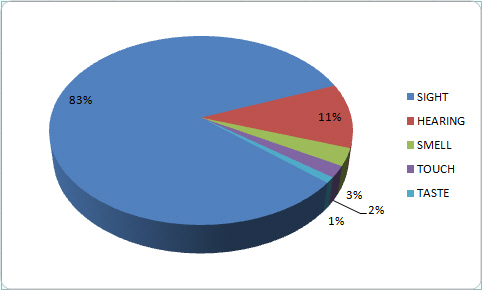
Impact on the brain of information from the senses during a visual presentation
A study at the Wharton school in Pennsylvania found that the retention of verbal presentations was only 10%. This means that a verbal presentation requires frequent repetition of key points to be effective. By comparison, the retention rate of combined verbal and visual presentations is 50%. This means you will achieve a 400% increase in efficiency through the use of visual aids. The study also found that using visual aids cuts the average business meeting time from 25 minutes to 18 minutes - a 28% time saving.
The Power Lift
To keep control of where a person is looking, use a pen to point to the presentation and, at the same time, verbalize what he sees. Next, lift the pen from the presentation and hold it between his eyes and your eyes. This has the magnetic effect of lifting his head so that now he is looking at you and he sees and hears what you are saying, achieving maximum absorption of your message. Keep the palm of your other hand open when you are speaking.

The Power Lift - using the pen to control where a person looks during a presentation
Women hold more direct eye contact than men during presentations, especially when they are not talking. When women are talking, however, they avert their eyes more than men do.
Men stare more at women than vice versa and men give less direct eye contact when listening to other men than when listening to women.
Summary
Where you direct your gaze has a powerful impact on the outcome of a face-to-face encounter. If you were a manager who was going to give a piece of your mind to an employee who was out of line or a parent reprimanding a child, which gaze would you use? If you use Social Gazing, the sting would be taken out of your words, regardless of how loud or threatening you might try to sound. Social Gazing would weaken your words but Intimate Gazing could either intimidate or embarrass them. Power Gazing, however, has a powerful effect on the receiver and tells them you mean business.
What men describe as the 'come-on' look that women use relates to a sideways glance, dilated pupils and Intimate Gazing. If a woman wants to play hard to get, she needs to avoid using an Intimate Gaze and use Social Gazing instead. But most men miss a lot of it anyway. To use a Power Gaze during courting would leave a man or woman labelled as cold or unfriendly. When you use an Intimate Gaze on a potential partner, however, you give the game away. Women are expert at sending and receiving this gaze but, unfortunately, most men are not. When men use the Intimate Gaze it's usually blatantly obvious to women and men are generally unaware of having been given an Intimate Gaze by a woman, much to the frustration of the woman who gave it.



